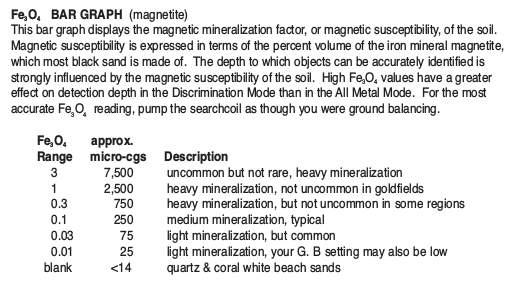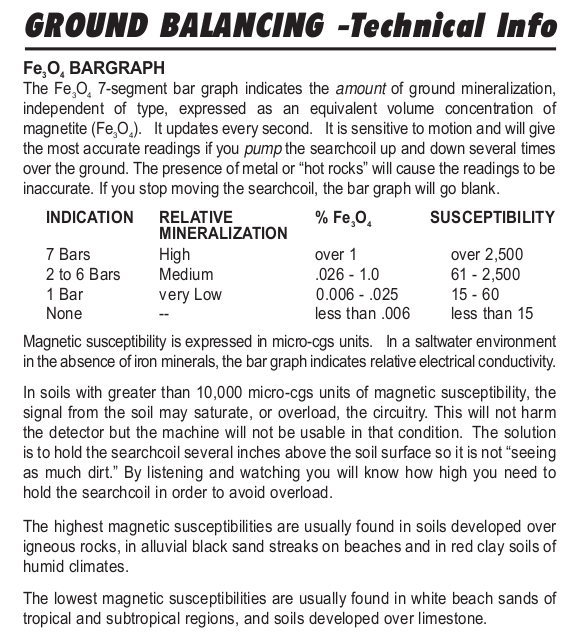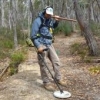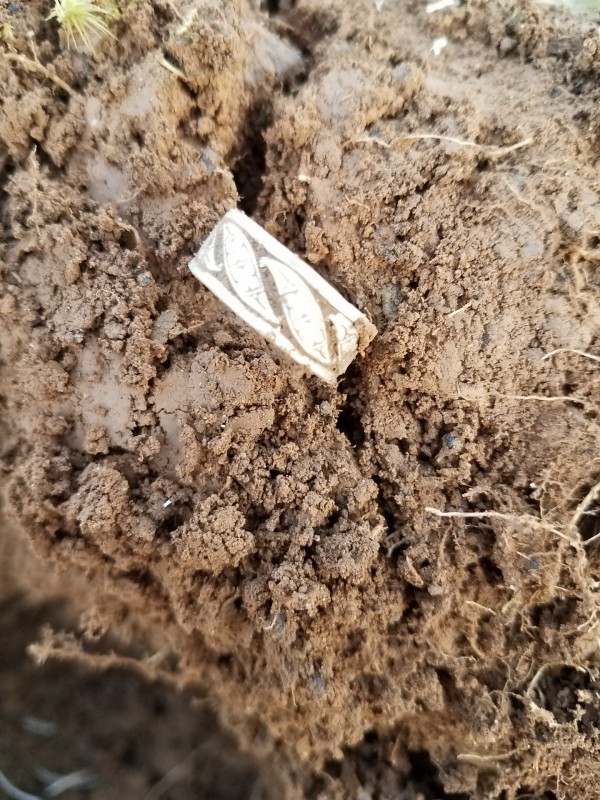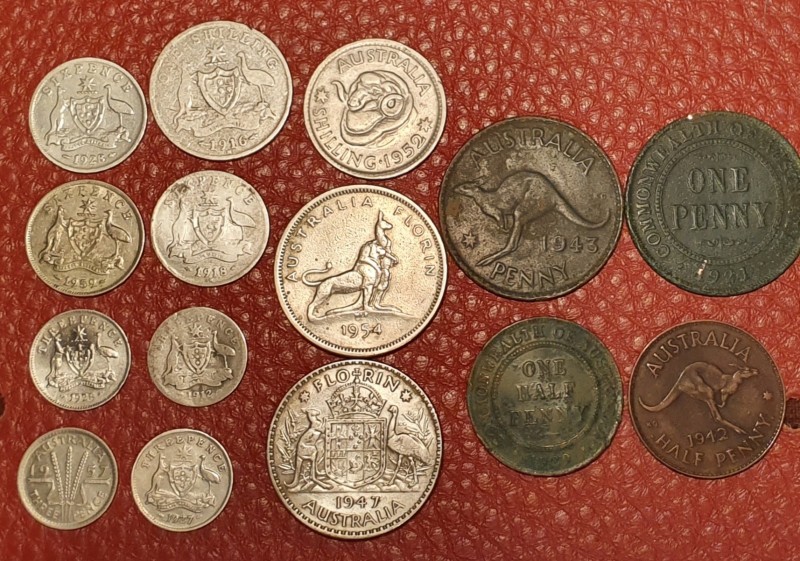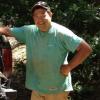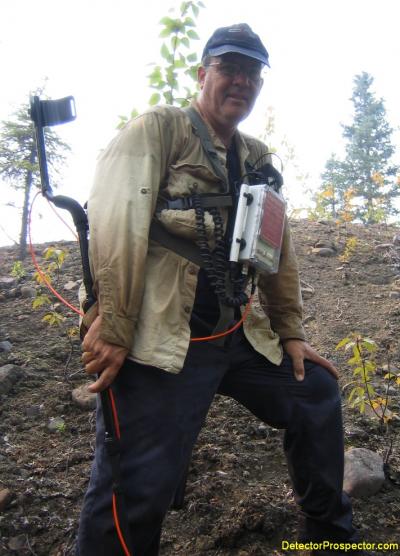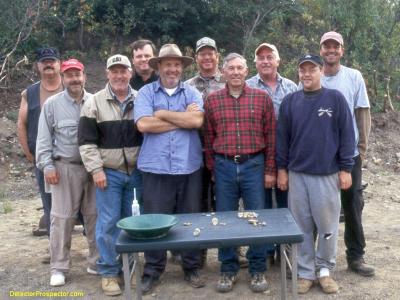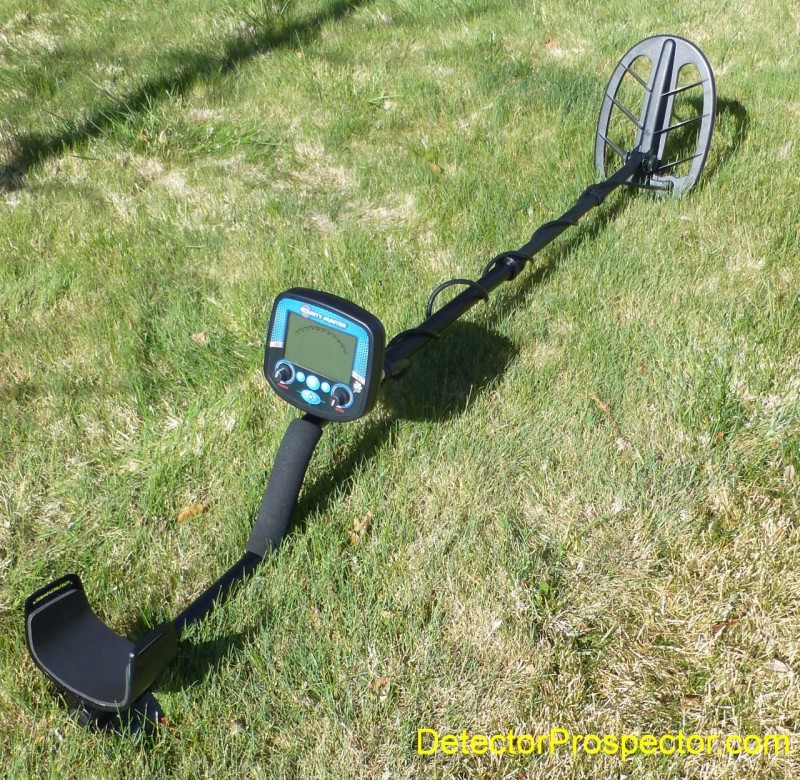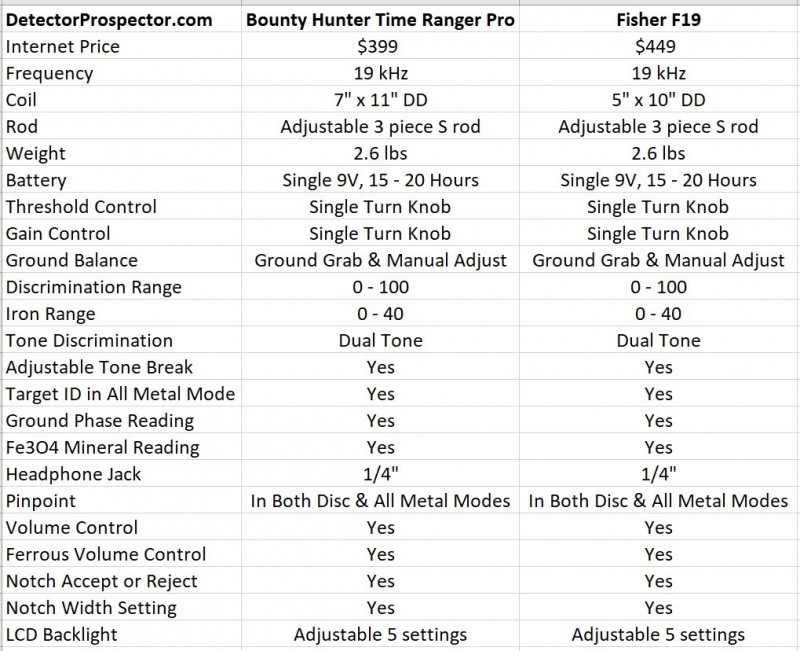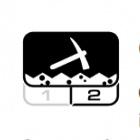Leaderboard
Popular Content
Showing content with the highest reputation on 04/22/2020 in all areas
-
Responding to Peter in SA. Back in the mid 1980s I had been involved in the introduction of the Minelab GS15000 metal detector at Wedderburn in central Victoria. The early Minelab crew were a bunch of clever people from Adelaide university who got together to produce an Australian made metal detector which could challenge the big American companies. Wedderburn was chosen for testing and development due to its reputation of having very mineralized, difficult soil conditions. A number of Australian built detectors had failed to live up to expectations, defeated mainly by the hot soil conditions in Western Australia and central Victoria. The GS15000 proved to be a better machine for these conditions than its competitors and soon gained acceptance throughout the gold detecting fraternity. Craig Hughes, who was part of that early team came up with the idea of a coil towed behind an ATV. An area near the famous 'potato patch' just out of Weddurburn was chosen for testing, using a Honda three wheel ATV (horrible unstable beast of a machine). The coil was fairly small, but I can't recall the exact size. A GS15000 provided the electronics, and although noisy, did work with a small bit of gold recovered. (a few grams) Even though the manual ground balance made for uncomfortable detecting, the concept had been proven, much to our surprise. In 1987 I was involved with the testing of the GT16000, which was the first ever automatic ground tracking. This machine was a major breakthrough and really put Minelab on the map as a serious contender for the title of the world's best gold detector. It dawned on me that the feasibility of tow detecting was a reality now that a detector could stay balanced automatically, and I contacted Don McCoy, one of the original Minelab team and asked him to build me a coil suitable for towing. The result was a rectangular coil about 3' x 2' which was very stable and sensitive. I purchased a Yamaha 4 wheel ATV as a tow vehicle and with the addition of a suppressor managed to keep the EMI to a minimum. The first day of testing yielded a 6oz lump, which was a big surprise, and paid for the ATV in one hit. I sent Don some nice specimens as payment for the coil. I later sold that coil through Miners Den in Melbourne when the SD2200 was introduced. The SD2200 was of course the first auto ground tracking pulse induction detector, and naturally I soon made plans to adapt this concept to 'sledding'. John Hider-Smith, Ian Jaques and myself had been involved in prototype testing of Minelabs first pulse induction detector, and Bruce Candy had taught john how to wind mono coils. One of Johns coils was used in the first PI tow coil testing where we discovered that a 4 stroke engine was not feasible due to the high susceptibility of PI to EMI. With experimentation we discovered that diesel was the way to go as no spark was required for the engine to run, and an isolation switch for the alternator solved any EMI problems. We later used a GPX4000 which worked even better. I have to close now due to having to shut down internet but will add further details later.15 points
-
The original PI sled was all plastic construction with height adjustment and replaceable black plastic poly pipe skid liners. Mounted at the rear of the sled was a plastic tank and spray nozzle. A small windscreen washer motor was wired to a button on the handlebars, and a spray of agricultural dye marked the approximate target site when a signal was received. At the end of a session of gridding hand held detecting pin pointed the target site, and detected objects recovered. This sled worked well in Victoria on pastured paddocks, however the abrasive conditions in Western Australia soon destroyed it and a different concept was required. A visit to a mining scrap yard resulted in a short length of conveyor belt forming the basic skid requirements with a section of split poly pipe transversely snapped over the leading edge of the belt to assist passage over rocks or other obstacles. The box containing the 38" coil was then mounted on the belt with large nylon nuts and bolts which were countersunk into the rubber belt. A simple rope was then used to tow the contraption. This set up proved to be simple but highly effective. Geo marker flags were then used to mark targets. This involved stopping the vehicle and marking the target site by hand each time a signal was received. Not a huge inconvenience where targets were few and far between. It was my pleasure to have had the company of the late Jim Stewart and James Beatty on that trip to WA. They had traveled over with a very large double D coil that Jim had built and was hoping to use this coil to achieve greater depth in the hot WA soils. We conducted some tests using hid double D on the sled, but it was not successful as the double D required very slow speed to be responsive. Hence we discovered that Mono is the way to go for sledding.8 points
-
5 points
-
5 points
-
5 points
-
4 points
-
A couple of points when sledding. Noise suppression coils sacrifice sensitivity for quieter use. Longer cables equal less efficiency. The old KISS principle is best (keep it simple, stupid) The sled that I still have works best in conjunction with the GPX4000 running on sensitive smooth. I have tried other models but for some reason the 4000 is the best. The 38" round mono easily picks up .22 slugs at 5KPH with a clear unmissable signal.3 points
-
3 points
-
To Fred’s family and friends, I’m sorry for your loss. I never met Fred but always enjoyed his humour when he commented on peoples posts. When i saw a comment from the man in the pink/red shirt i knew it would either be witty, funny or kind. May you find some comfort in knowing that many others thought highly of him, including myself3 points
-
Fred had many lessons to teach. One of them I learned by taking a trip to Tucson for an outing. I had decided I was going to go through Yuma to a place called Potholes where Fred had been in the past. I asked him where to hunt and he gave me the 'lay of the land' so to speak and told me to hunt under the wires. Well, I'm not that great with directions but I did find the power lines and I hunted some likely spots and I found a nice nugget of a couple of grams. There was also a few more smaller ones and interesting trash. After the trip was over I called Fred to thank him for the tips on the place and I told him where I had found the nuggets. (This is the information you get back if you share.) Fred listened and thought about it a little while and he told me that I had gone to the 'wrong' wires! haha We had a chuckle about it and he wanted to know where I parked and where I found them. About 3 weeks later there was a posting on the forum of some nuggets Fred had found. (More than I had found) He told everyone he got out of his truck, geared up and found them within 30 feet of the truck. (He didn't tell everyone our location.) That is where I had parked! haha As it turns out Fred found lots of nuggets where you park and some of us have taken advantage of his lesson over the years. I know I hunt roads and parking lots more now because of Fred.3 points
-
Hunted Paul’s neck of the woods for 5 hours in search of that gold or bust coin. No luck only dug up the usual targets you find at old settlements.The last time I dug up old coins here was back in 2005 when I dug up a 1816 2 reale which is rare to find here in this part of California (Central Valley) and a 1850 French coin with the explorer Xs. Both coins now at the county museum with Paul’s finds. The ground here is fertilized dirt 700-800gb and the MDT handled it well. The iron isn’t as bad as the dry river dump site where I get overload message on the MDT over large iron. It was great to get out to do some hunting, beautiful weather and weeds were not a problem. Better luck next time. Denny2 points
-
I agree, power is just one part of the equation. Circuit design, especially a well designed noise eliminating receive circuit using the highest quality components.... there is a lot more difference between a TDI and Minelab than just battery power.2 points
-
2 points
-
We were looking for stage-robbery loot along a stage road that was also an emigrant route. The desert road mostly follows the stage road, but here and there, the emigrant wagons cut a really deep gouge into the soil, and the desert road deviates to avoid those spots. We don't generally hunt the road, as there's too much modern junk, like .22 shells, but yesterday we did hunt the deep sections of the old route, and found a bunch of interesting items. I found an old pocketknife, with only one sideplate, but the plate was mother-of-pearl, which is pretty rare. I also found an unfired .38 S&W round, and a .38 case with no headstamp. Also, the business half of an old hatchet. But the best was the last thing I found....my first Barber dime...a 1902 in excellent condition once I cleaned off the accumulated crud. The places Dave and I hunt, coins are really rare. We also located the encampment location where they spent the night. Lots and lots of trash. We'll be getting to that spot in the future. They couldn't make the spring on the Butte in one day, so stopped at roughly the same place as each wagon train went through. Dave found a pile of stuff, too, but no coins. His finds included a nice obsidian arrowhead, which he left where he found it, of course. He also found a really old spoon, that had broken, and had been repaired by wrapping wire around the neck of the handle. The crushed cartridge is a .44 of fame and legend...LOL I imagine that cartridge with no headstamp is also really old. I was using the TDI SL, and the SP 350 8 x 14 coil. I was running in ALL, but only digging the high conductor signals mostly. Digging low conductor signals results in wasted time...just too much small iron junk. Jim2 points
-
I just decided to have both. I bought the Simplex forst and enjoy it. I wanted the Multi IQ tech as a secondary machine. They are both so inexpensive that it made sense to just buy them both. I ordered rechargeable batteries for the Vanquish 440 and I am set. best of both worlds.2 points
-
We have beaches that contain black magnetic sand mixed in with the silica sand. It's a headache for most detectors, loss of depth, normally good target ID's drop into the lower range. Iron will wrap around and ID in the silver range. Good chance your passing all the good targets and digging more trash. Better to dig all ID numbers that the sand causes the detector to drop 30 ID numbers that are normally 80-90"s. That's the reason why many claim all they find is junk on the beach. The beach causes a loss in depth, very hard to find a coin on edge. The only trick I find that works well, is a smaller coil and hunting in a true threshold based all metal mode. Listen for a sharp narrow coin size tone and dig. The best detector here is a Pi or a Minelab.2 points
-
Hi kac, I agree, I wish the Kruzer came in a single frequency 19 kHz like the Anfibio. I am basically learning the Kruzer so I can move on to the NokMak simultaneous multi frequency when it comes out and I did not see any point in buying a Simplex. Actually, in my mineralized dirt, 3 Tone at 90 or above is the only way I can get any depth at all. Otherwise, 3 Tone at 89 or below is only good for recent drops that are just in the thatch or on the service. 3 Tone at 90 gives me fairly solid target IDs in the correct tone bins and still is pretty fast. Yes, I do get lots of small stuff going off but since I use an Equinox and ORX I am used to some noise. I could not stand the audio in 3 Tone with sensitivity at 89 or less. Sounded like AM radio static and in this dirt it wouldn't even give a numerical ID on 4" targets. I really like how I can quickly switch from 3 tone to 2 tone or 4 Tone to check a target more closely with a quick push of a button. Same thing on the Makro Racer 2. Jeff2 points
-
I really thought I saw a 19khz single frequency Kruzer at one time. You are right. That's kind of a bummer because I really like the number spread on mid/low conductors at 19khz. as it works very well for me picking through can slag. I completely agree 3 tone is poor at 90 gain. I actually don't go past 85 which I consider the brink for 3 tone which is fine as you probably want to use that in trashy parks and doesn't make sense to try to search 14-16" down in a trash heap as everything on top is going to pollute your signals. I find the audio tricky to learn and taking me some time but that is me as I like that old boring monotone from my Tejon. When using 3 tone and that blazing fast recovery if you come across multiple targets and trying to see what is what, toss it in 4 tone mode and go super slow over them. In 4 tone start your isat at 1, gain 85+ ( i have mine at (95), Iron audio at 2 so it is soft and no discrim. You should be able to start to hear the different targets as you pass over. Handy also if you get a broken target signal from high disc settings.2 points
-
I find my self doing better with the analog only and no vdi. I dig less trash and find better targets. Not sure how well you can apply this to a vdi machine but the way I run my Tejon and for those that aren't familiar with them you have 2 dscrimination circuits you can toggle between. In an unknown area I will start with disc 1 set to just trim out iron rust like nails and rusty halos etc. and if i start hitting can slag or modern trash I will nudge it up past foil and even at the bottom line of nickel. 2nd disc I use as a range check. Usually set it for pull tab which is the bottom of zinc pennies. Poorly degraded zincs will break at that point too. When I hit a target the first thing is located it. This means hitting the target in a couple directions to make sure I am over it. Next I listen for duration of the sound as i pass the coil over. This tells me size. Next I check how loud it is which can tell me a couple of things such as depth or extremely high conductor like a can or screw cap. Lastly with the pin point mode I check how the vco reacts. Does it have a flat tone as I pass over, usually aluminum has a bright flat sound, or does it have a roll to it. To access the disc 1 you just run the machine, disc 2 by pushing the trigger forward and pinpoint vco you pull the trigger. Now why do I do better with this? Really simple. I don't have numbers telling me what the target might be so I have to rely on my imagination and experience with the machine to determine whether or on I should dig. I find that when I use my AT Pro or my Kruzer I catch myself doubting the target and too many times passing over. I also find myself tired if it is just beeping too much. The Tejon when set properly is quiet as a mouse and you only hear targets in the range your looking for. This means sometimes making another pass with different settings in if your cherry picking but for the most part it isn't necessary and I only do that in extreme trash conditions. There are a couple of tricks I learned with the Tejon that seem to help on the vdi machines but find the vdi's don't necessarily blend frequencies as well As an example if I have small iron that I disc so it just breaks (broken signal) on an iron nail and put a dime near it, I will actually gain depth on that dime. This is because the signal on the dime is typically weak on the Tejon as it picks up on lower conductors better (louder) and the iron brings the dime down so I hear it louder. It don't believe it makes the dime signal stronger in the sense of depth but more it changes the bias of the machines detection to make it just louder. Last bit on the Tejon I found is you don't always need to blast if full gain all the time as it tends to flatten the audio especially on shallow targets in the case of coin shooting in a park. Depth loss when dropping sensitivity is not that much maybe an inch or so between 50% and overload (quarter turn past 10). I usually start at 10 and if I am blasting too much trash and can't hear the difference I will drop the gain back. If I have a fringe target I will just crank it up. Keeping that in mind and using good coil control with consistent level sweeps enables me to be more productive with no #'s. That doesn't go without saying that the numbers do help. But how many times can you catch your self looking at the numbers first when you first get a hit and not the coil and try to locate the target first THEN use the #'s to take some of the mystery out. Try digging some targets without even looking at the #'s just the audio. Just something I think may help.2 points
-
If you are even considering an ATX, then a GPX should also be on your list. The nuanced audio on a GPX is better for target identification and pinpointing than the ATX and the GPX has better iron rejection features.2 points
-
Occasionally in posts I see reference to mineralization and how it affects detector performance. It is often vague with usage of words like 'mild, moderate, severe'. In fact several detectors have the capability of measuring it. Two of mine -- Fisher Gold Bug Pro and Fisher F75 -- have that capability. Until now I've typically paid little attention to it. (Magnetite) mineralization and its effects are clearly important in many detecting for native gold situations, but it's also meaningful for other forms of detecting, if nothing else when comparing notes on detector performance. Extreme cases we've seen are Tom Dankowski's reports on the depth he gets in the sandy, non-mineralized soils of Florida vs. Steve Herschbach's difficult Reno parks. An even more extreme example has been reported multiple times by Mark Gillispie in coal ash laden school yards. Here are the pertinent sections from the F75 and F19 (Gold Bug family member) user manuals respectively regarding the meanings of their magetite measurements: Personally I prefer the F75 readout since it quantifies the meaning of the bar levels. Not sure why the Gold Bug scale wasn't equivalently defined, maybe another example of "don't step on the toes of the more expensive model" syndrome.... Yesterday I made measurements in my back yard with both detectors, two coils each (stock Fisher 5" round DD and 7"x11" DD). In all cases I ground balanced before taking the measurements. For the F75 the ground phase values in my backyard as a whole were 61 with its 5" coil and 64 with the 7"x11" coil. In those locations (still F75) the 5" showed 2 bars and the 7"x11" was about 50-50 divided by 2 bars and 3 bars. The measurements made with the Gold Bug were nearly identical in terms of the bars shown (2 with 5" and 2-->3 with 7"x11") for ground phases of ~64.5 and ~60 respectively) even though the scales on the two detectors don't really align in terms of the units of measure. Now here's a possibly interesting and serendipitous observation: for my teststand the readings were 3 bars in three of the four cases (I missed the measurement with the GB Pro and 7"x11" coil). If you refer back to the linked thread there is a drawing which shows a concrete layer at 15" depth. This was made with a store bought bag of concrete mix. Those contain not only the cement but also sand and gravel filler. Where did that sand and gravel come from? I don't know but it sure appears that it came from a site more mineralized than my back yard! I vaguely recall previous measurements I've made (but failed to record -- my bad) in my back yard where the F75 read 4 bars. One thing I wonder about is how much soil moisture affects the measruement. (We haven't had rain for a couple weeks so the ground is considerably drier than typical for the late autumn, winter, early spring months here when I likely took those earlier measurements.) But there are other variables so I wouldn't conclude that moisture does have an effect. One would hope not, but certainly dectectors are known to perform differently when detecting in various soil moisture conditions which is why I wonder. As always I'd be interested in seeing other measurements (regardless of detector model) and comments.2 points
-
Thank you so much Norm for starting this post to let everyone know the sad news about Fred. I know Norm and Freddy were dear friends so it was fitting that it was Norm that posted the news. I loved reading all of the wonderful heartfelt comments and the great photos - it really is a celebration of his life !!! If anyone has more photos I think it would be wonderful to see them. I know it will bring a lot of comfort to Jonni and Fred's family to hear all the stories and know how much he was loved and respected by so many. Jonni - you and Fred were so kind to me when we camped at the Lucky Fox with Norm, Heather, Mike and Michelle. I am so thankful and feel honored that I had the opportunity to get to know you both a little better and enjoy that special time with everyone. My thoughts and prayers are with you and your family.2 points
-
Reg, You gotta understand the thrill of seeing someone swinging a coil on TV. That means for those of us who do it we can send someone a link and show them what we do. You can show the wife and she'll understand why you want to spend so much time in Australia. This show is not produced as well as The Detectorists from England but you can see some digging and scratching which is better than 95% of the other TV that is on. ANYTHING to keep the news channels off. Mitchel1 point
-
See my post above. The Xpointers and PulseDive are both PI.1 point
-
Simon, the problem with your magnet idea is that it would soon be clogged with stones with a high iron content. Mitchel, the beauty of using a base of conveyor belt is that the coil sits flat and parallel with the ground. this makes for good ground tracking. When used on pasture the grass is flattened by the weight of the belt keeping the coil as close to the ground as possible, but the grass stands up again once the sled has passed over it.1 point
-
I have a current account on their website with current email address, have sent in numerous warranty cards, won find of the month, work with engineering, have dozens of articles published in their website. Never ever get a promotional email or real mail from them.1 point
-
I am surprised that no one has shown some of you older folks what is on the back of a Merc. Probably when I was about 10 years old, a man pointed out those features to me. {a very long time ago) Only the San Francisco mint has the snake, all have the bear walking on all fours from left to right, across the bridge and the leaning tree. I still look for the naked lady on everyone I find! Norm1 point
-
If you just choose one of the modes (preferably Park 1 or Field 1) and leave the detector in its default settings, you effectively have a beginner's detector. Certainly the intentions of the user and his 'natural' tendencies when it comes to technology should go into the choice. Personally I find the term 'beginner detector' somewhat condescending, although typically it's not meant that way. There are many sophisticated and experienced detectorists who use these beginner detectors, some even exclusively. Now if you really want bells, whistles, and (virtual) knobs, get a White's V3i!1 point
-
I hate those modelo foil covered bottle caps they fool me everytime.1 point
-
1 point
-
1 point
-
Congrats, good run. Any more bits from the harmonica? Best I found was the wood insert but covers missing.1 point
-
I am rethinking this all over. This is not in response to Phoenix post, but more Phoenix reminded me of the minefield I was about to embark on and that was a great reminder. I need to think through the right way to do this and the right way to present the results and unless I have that figured out, I am not venturing close to that minefield. I am more of a features comparison guy (compare detectors on paper) and then post my finds results and let those speak for themselves. The Simplex obviously gets it done. Phoenix posted some spectacular coin shooting results pre-update, so those don't lie. Recently, I have had only a few chances to get out before things were basically shut down for me as far as site access is concerned. Because detecting time was such a precious commodity, I have had little time to experiment in the field with a new detector, preferring to hit the hot spots with my tried and true reliables (Deus/Orx and Equinox). Simplex and Vanquish have only been recently acquired and I have not had the opportunity to really run them through their paces in the field. The only thing that made me dust off the Simplex in the first place was the new update and I thought here was a unique chance to get some controlled pre and post updates in the process since, unlike Minelab and XP, Nokta doesn't presently allow you to roll back to a previous update at this point (at least that is how I understand it), so it was now or never if I plan to get the Simpex updated. I have gone over the test garden once again and experimented with different Simplex modes and found that Beach mode, for whatever reason, gave the best sounding results on the targets. I was able to detect most targets in that mode. Surprisingly, AM which should mimic my Deus pitch mode and Park mode on the Simplex were not as good. AM really bothered me, it should be the deepest. Park, I could understand because apparently, Nokta focused on separation in Park (hence relegating the original Park to Park 2 status and adding a deeper but less response Park 1 mode in the update). I need some more run time to garner real results and will either post my results solely in writing or will post videos if I think they are actually useful. Unfortunately, I have a face made for radio, so we'll see. More to follow....I will post the results in detector comparisons since I will be using Vanquish as a reference and perhaps the F75 as a similarly equipped single frequency detector for comparison. F75 = 13 khz/Simplex = 12 khz. Gives me a reason to dust off the venerable F75.1 point
-
1 point
-
This is an update after lots of testing of the Makro Kruzer single frequency 14kHz. Honestly Kac, Nokta Makro only makes one single frequency Kruzer and it is the 14 kHz one that I have......... So, I read through everyones posts about settings and target ID stability and accuracy. It all makes sense. It is what I would usually do in moderate to high mineralization= lower the sensitivity (generally 80 or less) until chatter from EMI and ground noise is acceptable while raising discrimination just enough to get rid of cold/hot rocks and ground mineralization (4 or 5 works good here). In Gen, 2 Tone, 4 Tone and Deep Modes that works just fine. In Beach 2 Tone Mode it works fairly well. In 3 Tone, which is supposed to be for higher modern trash areas it does not work at all in my soil conditions. So, somewhere in the back of my muddled brain I seemed to remember something about 3 Tone Mode on the Kruzers having super fast recovery speed up to a sensitivity setting of 89. At 90 sensitivity in 3 Tone the Kruzer goes into a boost mode with a bit slower recovery speed and longer audio and target ID response. I think I read this on Monte's site.........thanks Monte. With this adjustment of keeping sensitivity at least at 90 with discrimination at 4 or 5 and ISAT at 1 (which really seems to be some kind of IMask) I can get much better target IDs and can also get the correct tones for the tone breaks I have set for the most part. I am mostly concerned with getting some idea that I am detecting a low to mid conductor instead of a high conductor. Once I get used to doing a bit of mental target ID averaging by noticing target depth and more tone quality nuance recognition, I think I may be okay. I know this does not make much sense theoretically but it makes 3 Tone very usable. Before setting sensitivity at 90 in 3 Tone, the audio was absolutely awful with mid and high tones being blended together into what can only be called ugly static and target IDs all over the place between 60 and 99 on every target past 3" depth. Now, I get beautiful, clear tones. I don't mind a bit of blended audio but pure static is not okay. I seem to remember reading about the F75 needing enough information to decide on a target ID that was dependent on having enough gain......maybe I'm dreaming again OR maybe the Kruzers have something similar. I have a 5" nickel in my test bed that is the dividing line between my detector haves and have nots. In Kruzer 3 Tone with gain at 89 I get next to nothing on that nickel for audio with the occasional click or pop and numbers in the 80s and 90s. With gain at 90 the nickel hit with beautiful mid tones and numbers from 28 to 40 which is good enough for me with nickels hitting at 30 normally. I have read through the manual for the Kruzer/Multi Kruzer three times. This information is not in the manual. Maybe I have an older version and there was an update. I felt like I was doing a good thing by buying a 14 kHz Kruzer with everything included and in great shape for less than the price of a Simplex WHP and I was helping a struggling dealer out. I was starting to wonder if I had really done something stupid. After today's work on this problem by all of you who replied, offered help and by my testing........I'm good!!!! Jeff1 point
-
Man, hunting was much harder this time. After quite a bit of rain last night the ground was alive with false audio reports. I knew right from the start the SL required some delicate adjustments. This coal waste is very conductive, especially when it's soaked. After digging at least 15 holes out comes a quarter, then 1946 wheat penny. Then after another 45 minutes of digging and maybe 20 additional holes, finally a nice find. I'm so grateful after an extremely stressful day at work.1 point
-
Disc doesn't effect depth here either. Same on my Tejon if I cranked up my primary disc to above foil which I often do and leave 2nd for high conductor check. Depth is still the same on a nickel even if the trim is a hair below. Noah is spot on with the results he as I found the same. The audio is harsh but does have a lot of nuances to learn. Wish they had the same smooth audio in all modes as they have in the gen mode. That would be killer! Forgot to mention did you try beach mode to see how it handles your ground? Don't think it has ground breaking depth but may handle the harsh soil better. Good to see if it calms it down and narrows the issue to the ground or maybe there is something else going on. Dogdog mentioned to me he has a hard time in bad soil where he is and beach mode works there.1 point
-
That's a 20 Euro cent coin (i.e., 1/5 of a Euro) - Comprised of "Nordic gold" AKA as a gold colored copper alloy of the following composition: 89% copper, 5% aluminium, 5% zinc, and 1% tin. Could be the zinc or tin giving the lower ferrous tones. Looks like an Austrian mintage based on this pic1 point
-
Well, this hunt pre-dates the problems I had with the latest update, which is covered in another thread. I went to a local property that had been farmed for over 100 years. I used Park mode over a well grassed lawn opposite where the original farm house was built. The day was extremely hot, in excess of 40 Celsius and the humidity was close to 100%. Oppressive. 3 hours later and I had detected 15 pre-decimal coins. A terrific hunt by anyone’s standards. I ended up with what we call a full House. (A complete set of each coin issued during pre-decimal times.) In fact, I got equal to two of them. An added bonus was that one of the florins was a commemorative issue. The down side was that, subsequently, a neighbour of the farmer learned of my success and managed to convince the landowner to let him detect the property, trampling all over my permission. They’re out there folks. I was so impressed with the Simplex that I contacted Nokta and told them of my experience with the machine. They asked me to send a short story and photos so they could put it on their website. I did, and they did. More than that, the story and a photo was put up on Instagram and in a full page advertisement in an Aussie treasure magazine. A lot more than I signed up for. I don’t blame them really but felt I had been a little (Lot?) used. Yeah, I know, I’m sticking my head up here, too. Anyway, I have to say I am impressed that such a low cost machine can perform so well. I am impatiently waiting for the current pandemic to subside so I can get out and see just how well the latest update enhances the machine. It’s just a pity that I won’t be able to run over my original site as a comparison.1 point
-
By now most of you have heard of Fred's legendary Chile Verde. Many of you may not have the recipe. Here it is: my version of Chili Verde May not satisfy the purists.... a small batch: three pounds bbq pork ribs- boneless one large can of chopped green chili several garlic cloves one or two tablespoons of ground Red Pepper Two chopped serrano peppers and 3 to 5 whole, how hot do you want it? chop the meat, dump the rest in, cover with a beer and water, bring to a boil, simmer to your hearts delight! I like to thicken with cornstarch . I won,t be there...have fun! fred salt to taste1 point
-
Rest in Peace as you shall be missed by those of you and your knowledge has touched. Heaven has now received another whose detector is now on virgin ground with lots of finds for you to enjoy. We shall miss you, and we shall remember your words that you have given us. May your family know that we are praying for them during their time of grief.1 point
-
Fred's presence is going to be missed. Didn't we always know that if we were a touch off in our opinions or our information we could count on Fred to set us straight in his uniquely outspoken and bottom line way that was usually followed up with a comment of kindness that would let you down easy. I loved seeing that Fred had posted because, like most of us, I looked forward to an experienced and smart comment and he rarely let us down. He has undoubtedly moved on to better diggings and while his passing is our loss, it is heaven's gain. Rest easy friend and thank you.1 point
-
Fred always talked to me about being lucky rather than good. He would always jab me with that line and get a rise out of me. Most of it was because I showed him my 'lifetime nuggets' which he delighted in very much. I shared with Fred the enjoyment of finding meteorites. It was at one of these meteorite hunts that I went on that I found my first 'lifetime nugget' as Fred labeled it. Fred was not there but he was one of the first to see the 3.5/1.5 ozt nugget I found in Franconia. He told me at the time it was good any time someone could find over 1 ozt of gold. He told me he had not done it in all his years. (I hope he did it later because I saw one near an ounce.) A little less than two years after that first find I had a driven urge to go back to the same general area. I had a plan that wouldn't shake from my mind. It came together on a Thanksgiving day. I had slept in my Trooper the night before and when I got up I detected for about an hour before I found a large nugget. I called a few people and told them what I had and they told me that Fred and Grandpa John were at the Dale. I had to show it to someone so I packed up and drove the 150 miles to where they were. As it happened they (Jonni also) were just having a late Thanksgiving dinner and I was invited in the trailer to eat. I told Fred I had something to show him. I made him close his eyes and I put this object (20/8 ozt) in his hand. He said what is it? A meteorite? And then I watched him look at it. He knew I had another 'lifetime nugget' and he never let me forget it. I was a bit vague where I found it and later they thought I had found it in The Dale. Grandpa John told me in the morning that the nugget reminded him of a Goose Egg. That is how it got its name rather than Turkey Egg. I made a video just after I found the nugget that day and when I find it I'll post it to this thread in honor of Fred, the first person to see it other than me. Mitchel1 point
-
I’ve know Fred for several years! Back when I first met him was down in the Deserts of the Dale District. Back in them days, he’d head out in the morning and you wouldn’t see him till near dark. We finally found a nice patch down there where he could camp on the patch, lol. Hunted many times with him in the Rye Patch area and in the tall Pine Trees of Plumas County, CA. Great Conversations, always good food and a cold beverage! I’ll miss his smiling face and will be thought of during my Prospecting trips where we’ve stomped the same grounds at! RIP1 point
-
To those of us who knew Fred only through this forum and his writings in the ICMJ, it's still a huge and unexpected loss. I can't imagine how those close to him feel. My sympathy to them. I found Fred's postings and particularly his answers to questions both sincere and honest. He had a soft way of delivering a strong answer. Of all the posters here who I've wanted to meet in person, he was in the top 5 on the list.1 point
-
Oh my gosh, I'm very sad and shocked to hear that! He just posted on Wednesday!! I knew his health had not been well the last couple years but still.... 😞 Fred and I have been in regular communication, and in fact he was supposed to stop by for a visit this last fall, but got waylaid. I have not seen him since a brief get-together a few years ago. I really knew him more from a visit to my Moore Creek Mine many years ago. My condolences to his wife, family, and friends. He will be missed. https://www.detectorprospector.com/forums/topic/1045-steves-moore-creek-article-in-icmj/ Fred in 2005 at Moore Creek In front left with hat and blue shirt....1 point
-
I just added my vote to the Time Ranger Pro being a worthy competitor in the under $400 category. The TRP is a Fisher F19 sold under the Bounty Hunter brand name with different colors/decals and a slightly lower price. MSRP $449 discounted to $399. The relation to the prior First Texas 19 kHz models means the Time Ranger Pro has an exceptional number of coil options, both from First Texas and aftermarket companies. All coils made for the Fisher Gold Bug Pro, F19, and Teknetics G2 series will work on the Time Ranger Pro. NEL/Cors and DeTech make some excellent coils for this series. The Time Ranger Pro is for people who favor a detector that is designed primarily for separating ferrous and non-ferrous targets. It has a very strong threshold based all metal mode that puts a target id on screen via a discrimination circuit running in parallel. The discrimination mode is set up primarily as a two tone audio with displayed target id. The break point between the high tone and low tone is highly adjustable, allowing the savvy detectorist to decide just how much ferrous discrimination they want to implement, a large advantage over detectors with a fixed ferrous break point. The low ferrous tone has its own independent volume control. The 19 kHz frequency favors low conductors, and so the Time Ranger Pro is an excellent gold nugget, gold jewelry, and relic detector. It excels on thin and small cut coins as are found in Europe. With a small coil its separation capability rivals the best made in dense trash. The Time Ranger Pro is a decent coin detector, but the high frequency means it only rates as good, not up with the the best, on larger silver coins like quarters, and the discrimination tone and notching options are very basic compared to many detectors designed specifically for U.S. coin detecting. European hunters will have no issue with this as they tend to non-ferrous hunting and the TRP favors the smaller silver and gold coins they hunt, but a person wanting to cherry pick U.S. coins in park settings will find the discrimination options to be quite basic. They are however sufficient to the task, and the 19 kHz circuit exceptional resistance to electrical interference means this is an extremely well behaved machine in an urban detecting environment.1 point
-
I have been metal detecting for over 45 years now and have waited decades for a metal detector like the Equinox 800. Until now the so-called "do-it-all" multipurpose metal detectors have been very limited in one fashion or another. In particular, there has been a wide gap between metal detectors that can handle saltwater very well and those that are very good at gold nugget prospecting. Waterproof detectors have also tended to be feature limited in the past, heavy, and usually expensive. I primarily prospect for gold nuggets, and hunt for coins and jewelry both in parks and at the beach / in the water. Historically I have needed different detectors for water hunting and for gold prospecting. Suffice it to say that the Minelab Equinox 800 is the first detector I have owned that can do all the types of detecting I like to do, and do it very well, if not better than other detectors. Add in the fact that it is waterproof, has built in wireless headphone capability, and is incredibly affordable, and you have a detector that pleases me more, and in more ways, than any other I have ever owned.1 point
-
I agree the Equinox would be more Europe friendly. Yes, the Safari did seem like it was tuned for high conductors and was actually pretty good on small fine coins.1 point
-
Hay alluminati, I don't come often on the forum ... Of course tou can't get conclusions out of this outing ! I completely agree...But I might think the Safari was (is ?) tuned ti higher conductives, while the Nox is more "europe friendly"... The Field mose is "europe-oriented", while the park mode is "US-orientend"...Maybe that's the key, explaining "polyvalence"...1 point

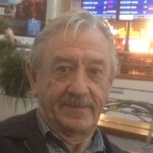



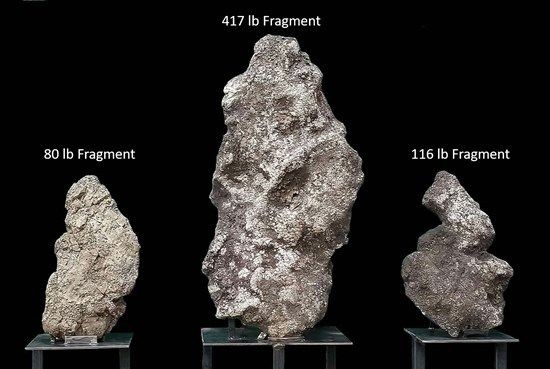

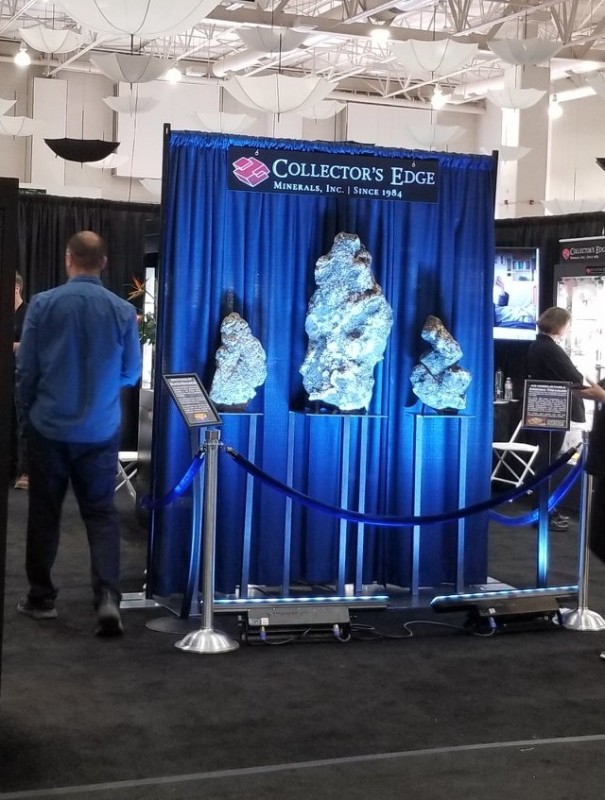
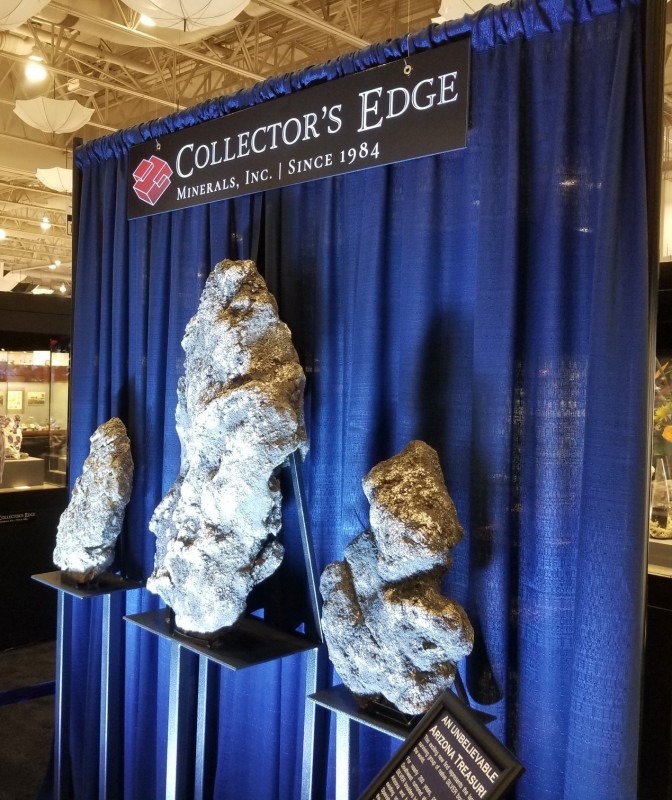

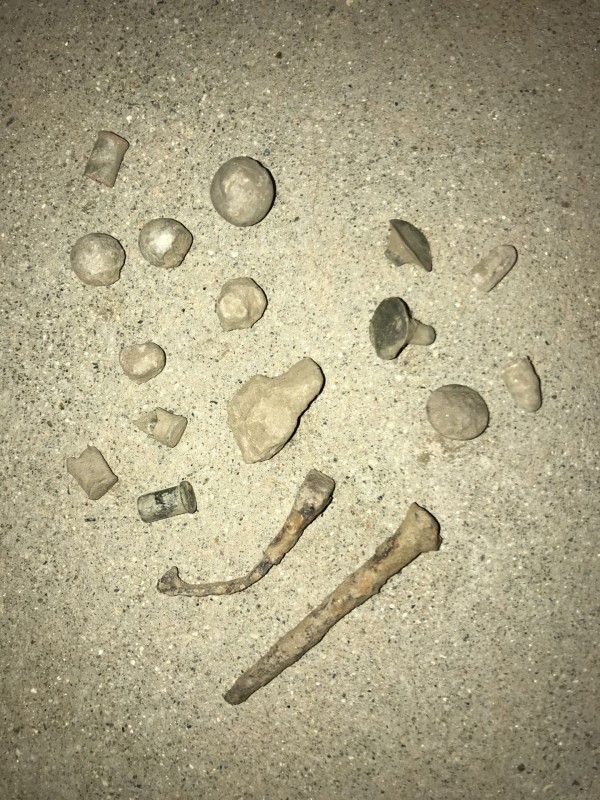
.thumb.jpg.ac5e8ee36e43bcab745dbc623fcf1874.jpg)




